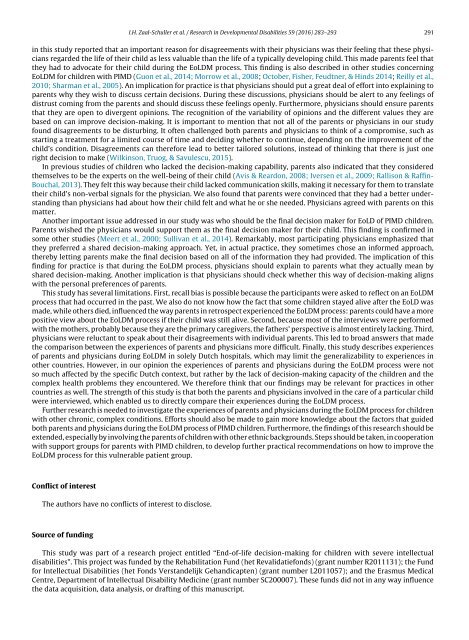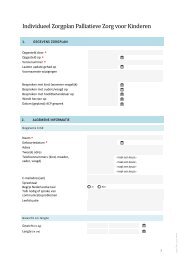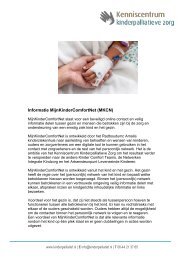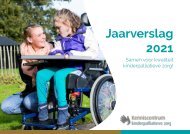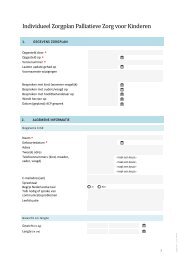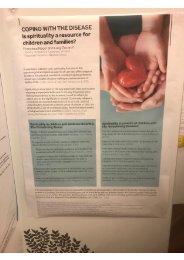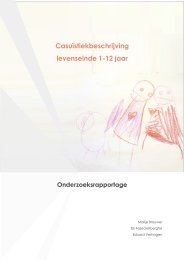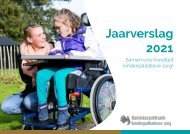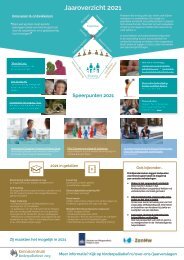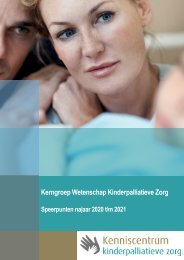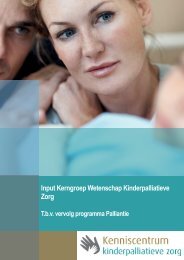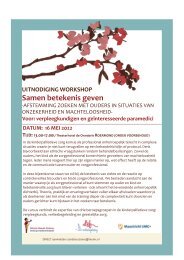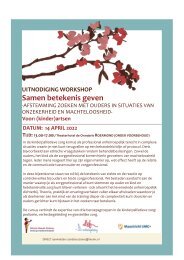How parents and physicians experience end-of-life decision-making for children with profound intellectual and multiple disabilities
Create successful ePaper yourself
Turn your PDF publications into a flip-book with our unique Google optimized e-Paper software.
I.H. Zaal-Schuller et al. / Research in Developmental Disabilities 59 (2016) 283–293 291<br />
in this study reported that an important reason <strong>for</strong> disagreements <strong>with</strong> their <strong>physicians</strong> was their feeling that these <strong>physicians</strong><br />
regarded the <strong>life</strong> <strong>of</strong> their child as less valuable than the <strong>life</strong> <strong>of</strong> a typically developing child. This made <strong>parents</strong> feel that<br />
they had to advocate <strong>for</strong> their child during the EoLDM process. This finding is also described in other studies concerning<br />
EoLDM <strong>for</strong> <strong>children</strong> <strong>with</strong> PIMD (Guon et al., 2014; Morrow et al., 2008; October, Fisher, Feudtner, & Hinds 2014; Reilly et al.,<br />
2010; Sharman et al., 2005). An implication <strong>for</strong> practice is that <strong>physicians</strong> should put a great deal <strong>of</strong> ef<strong>for</strong>t into explaining to<br />
<strong>parents</strong> why they wish to discuss certain <strong>decision</strong>s. During these discussions, <strong>physicians</strong> should be alert to any feelings <strong>of</strong><br />
distrust coming from the <strong>parents</strong> <strong>and</strong> should discuss these feelings openly. Furthermore, <strong>physicians</strong> should ensure <strong>parents</strong><br />
that they are open to divergent opinions. The recognition <strong>of</strong> the variability <strong>of</strong> opinions <strong>and</strong> the different values they are<br />
based on can improve <strong>decision</strong>-<strong>making</strong>. It is important to mention that not all <strong>of</strong> the <strong>parents</strong> or <strong>physicians</strong> in our study<br />
found disagreements to be disturbing. It <strong>of</strong>ten challenged both <strong>parents</strong> <strong>and</strong> <strong>physicians</strong> to think <strong>of</strong> a compromise, such as<br />
starting a treatment <strong>for</strong> a limited course <strong>of</strong> time <strong>and</strong> deciding whether to continue, dep<strong>end</strong>ing on the improvement <strong>of</strong> the<br />
child’s condition. Disagreements can there<strong>for</strong>e lead to better tailored solutions, instead <strong>of</strong> thinking that there is just one<br />
right <strong>decision</strong> to make (Wilkinson, Truog, & Savulescu, 2015).<br />
In previous studies <strong>of</strong> <strong>children</strong> who lacked the <strong>decision</strong>-<strong>making</strong> capability, <strong>parents</strong> also indicated that they considered<br />
themselves to be the experts on the well-being <strong>of</strong> their child (Avis & Reardon, 2008; Iversen et al., 2009; Rallison & Raffin-<br />
Bouchal, 2013). They felt this way because their child lacked communication skills, <strong>making</strong> it necessary <strong>for</strong> them to translate<br />
their child’s non-verbal signals <strong>for</strong> the physician. We also found that <strong>parents</strong> were convinced that they had a better underst<strong>and</strong>ing<br />
than <strong>physicians</strong> had about how their child felt <strong>and</strong> what he or she needed. Physicians agreed <strong>with</strong> <strong>parents</strong> on this<br />
matter.<br />
Another important issue addressed in our study was who should be the final <strong>decision</strong> maker <strong>for</strong> EoLD <strong>of</strong> PIMD <strong>children</strong>.<br />
Parents wished the <strong>physicians</strong> would support them as the final <strong>decision</strong> maker <strong>for</strong> their child. This finding is confirmed in<br />
some other studies (Meert et al., 2000; Sullivan et al., 2014). Remarkably, most participating <strong>physicians</strong> emphasized that<br />
they preferred a shared <strong>decision</strong>-<strong>making</strong> approach. Yet, in actual practice, they sometimes chose an in<strong>for</strong>med approach,<br />
thereby letting <strong>parents</strong> make the final <strong>decision</strong> based on all <strong>of</strong> the in<strong>for</strong>mation they had provided. The implication <strong>of</strong> this<br />
finding <strong>for</strong> practice is that during the EoLDM process, <strong>physicians</strong> should explain to <strong>parents</strong> what they actually mean by<br />
shared <strong>decision</strong>-<strong>making</strong>. Another implication is that <strong>physicians</strong> should check whether this way <strong>of</strong> <strong>decision</strong>-<strong>making</strong> aligns<br />
<strong>with</strong> the personal preferences <strong>of</strong> <strong>parents</strong>.<br />
This study has several limitations. First, recall bias is possible because the participants were asked to reflect on an EoLDM<br />
process that had occurred in the past. We also do not know how the fact that some <strong>children</strong> stayed alive after the EoLD was<br />
made, while others died, influenced the way <strong>parents</strong> in retrospect <strong>experience</strong>d the EoLDM process: <strong>parents</strong> could have a more<br />
positive view about the EoLDM process if their child was still alive. Second, because most <strong>of</strong> the interviews were per<strong>for</strong>med<br />
<strong>with</strong> the mothers, probably because they are the primary caregivers, the fathers’ perspective is almost entirely lacking. Third,<br />
<strong>physicians</strong> were reluctant to speak about their disagreements <strong>with</strong> individual <strong>parents</strong>. This led to broad answers that made<br />
the comparison between the <strong>experience</strong>s <strong>of</strong> <strong>parents</strong> <strong>and</strong> <strong>physicians</strong> more difficult. Finally, this study describes <strong>experience</strong>s<br />
<strong>of</strong> <strong>parents</strong> <strong>and</strong> <strong>physicians</strong> during EoLDM in solely Dutch hospitals, which may limit the generalizability to <strong>experience</strong>s in<br />
other countries. <strong>How</strong>ever, in our opinion the <strong>experience</strong>s <strong>of</strong> <strong>parents</strong> <strong>and</strong> <strong>physicians</strong> during the EoLDM process were not<br />
so much affected by the specific Dutch context, but rather by the lack <strong>of</strong> <strong>decision</strong>-<strong>making</strong> capacity <strong>of</strong> the <strong>children</strong> <strong>and</strong> the<br />
complex health problems they encountered. We there<strong>for</strong>e think that our findings may be relevant <strong>for</strong> practices in other<br />
countries as well. The strength <strong>of</strong> this study is that both the <strong>parents</strong> <strong>and</strong> <strong>physicians</strong> involved in the care <strong>of</strong> a particular child<br />
were interviewed, which enabled us to directly compare their <strong>experience</strong>s during the EoLDM process.<br />
Further research is needed to investigate the <strong>experience</strong>s <strong>of</strong> <strong>parents</strong> <strong>and</strong> <strong>physicians</strong> during the EoLDM process <strong>for</strong> <strong>children</strong><br />
<strong>with</strong> other chronic, complex conditions. Ef<strong>for</strong>ts should also be made to gain more knowledge about the factors that guided<br />
both <strong>parents</strong> <strong>and</strong> <strong>physicians</strong> during the EoLDM process <strong>of</strong> PIMD <strong>children</strong>. Furthermore, the findings <strong>of</strong> this research should be<br />
ext<strong>end</strong>ed, especially by involving the <strong>parents</strong> <strong>of</strong> <strong>children</strong> <strong>with</strong> other ethnic backgrounds. Steps should be taken, in cooperation<br />
<strong>with</strong> support groups <strong>for</strong> <strong>parents</strong> <strong>with</strong> PIMD <strong>children</strong>, to develop further practical recomm<strong>end</strong>ations on how to improve the<br />
EoLDM process <strong>for</strong> this vulnerable patient group.<br />
Conflict <strong>of</strong> interest<br />
The authors have no conflicts <strong>of</strong> interest to disclose.<br />
Source <strong>of</strong> funding<br />
This study was part <strong>of</strong> a research project entitled “End-<strong>of</strong>-<strong>life</strong> <strong>decision</strong>-<strong>making</strong> <strong>for</strong> <strong>children</strong> <strong>with</strong> severe <strong>intellectual</strong><br />
<strong>disabilities</strong>”. This project was funded by the Rehabilitation Fund (het Revalidatiefonds) (grant number R2011131); the Fund<br />
<strong>for</strong> Intellectual Disabilities (het Fonds Verst<strong>and</strong>elijk Geh<strong>and</strong>icapten) (grant number L2011057); <strong>and</strong> the Erasmus Medical<br />
Centre, Department <strong>of</strong> Intellectual Disability Medicine (grant number SC200007). These funds did not in any way influence<br />
the data acquisition, data analysis, or drafting <strong>of</strong> this manuscript.


